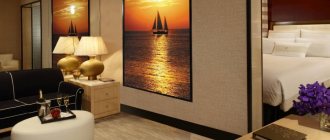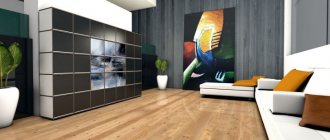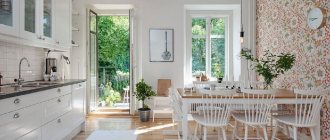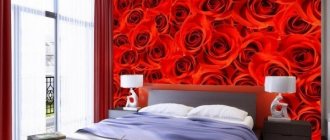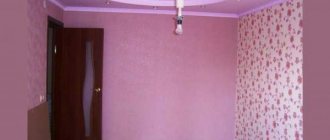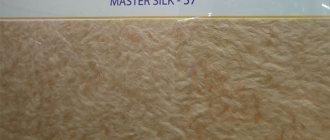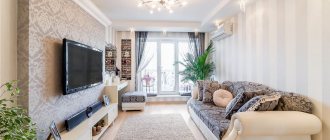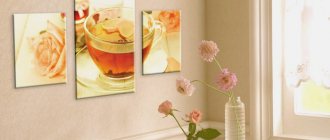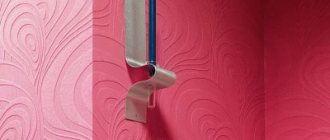There are many options why the question of how to glue non-woven wallpaper suddenly arises. For example, I didn’t like the work of three repair teams in a row. Or you bought beautiful wallpaper with your last money, and you’ll have to do the rest yourself. Or you just became interested in what they are and how to handle them correctly.
Non-woven wallpaper is the name of a non-woven material consisting of cellulose fibers, that is, environmentally friendly and safe for humans. They are practical, dense and durable, able to hide small irregularities on the wall, and do not fade in the sun. They have good sound insulation and hygroscopicity, which allows them to be used even in rooms with high humidity (kitchen, bathroom). Paintable wallpaper can withstand 12 repaintings without losing its original qualities. They can be used to cover any surface: plasterboard, concrete, brick.
In order to paste non-woven wallpaper yourself, you need to prepare the following tools: a metal staple, a wallpaper roller, a plastic staple with a soft angle, a plumb line or level, a 5-meter tape measure, a stationery knife, a pencil, glue, a glue bucket, a bucket of water and a rag to remove excess glue.
Advantages of wide non-woven fabrics
Non-woven fabric is a complex two-component structure. Its basis is cellulose, obtained as a result of complex barothermal treatment of wood followed by chemical splitting. The structure contains 67...78% of the wood processing product. The fibers are bound together by organic binders. They give strength and elasticity to the entire structure.
As a result of pressing at temperatures above 130 ⁰C, a non-woven fabric is formed; it is thicker and stronger than ordinary paper, although the primary processing processes are very similar. Hot stamping achieves an excellent 3-D effect of a complex surface structure.
Professional finishers regularly verify from their own experience that when using non-woven wallpaper, the effect of a monolithic, seamless coating of the wall surface is created.
Such an important indicator determines the high demand for such finishing material. There are other advantages over analogues made from plain paper.
- Significant width, reaching a meter, is one of the advantageous features of non-woven fabric.
- The process of gluing non-woven wallpaper onto the surface of the walls is quite simple in execution. Almost anyone can master the techniques of working with non-woven wallpaper. You just need to understand the features of the technology.
- The price advantage is that the total cost of purchasing a meter-wide roll is lower than what is required for purchasing and gluing two fifty-centimeter canvases (standard for regular wallpaper). At the same time, the glue consumption per unit of wall area is reduced.
- The range of non-woven wallpaper offered is so wide that you can implement any design solution. You can “play” with different wood textures, consider options using real and fictitious cuts of stone. Darken or lighten the corners of the room using one or another pattern on the surface of the non-woven fabric.
- The fabric contains: load-bearing base – non-woven fabric; non-woven wallpaper has a layer of paper on which the pattern is located (the main difference from completely non-woven wallpaper is that the pattern is applied to the layer itself); The surface vinyl layer is located on the outside, it gives a voluminous texture and a certain relief.
- Since the thickness of the new coating fabric exceeds the usual paper base, all existing wall irregularities are easily masked. Possible microcracks and differences in height are hidden. If there are panels at the bottom, then after gluing non-woven wallpaper, the joint cannot be found.
- The tensile strength is very high, it is provided by non-woven fabric. The thermoplastic surface layer prevents abrasion upon contact with objects and users' hands. The drawing is done with paints that do not fade over time.
- When using a surface covered with non-woven wallpaper, any dirt is removed by dry and wet cleaning. They can even be washed using the recommended solutions for such coatings.
- If you want to change the interior of the room, a wall covered with non-woven wallpaper can be painted with acrylic paints or alkyd enamels. In this case, you can apply a multi-color complex pattern using different painting methods (stamp, free pattern, stencils, knurling and other coloring techniques).
Attention! If desired, the surface can be repainted multiple times. The wallpaper canvas on a non-woven basis is glued so firmly that it can withstand a layer of paint up to 3...5 mm (such a layer is formed when painted ten to twelve times with alkyd enamel).
Is it possible to hang meter-long non-woven wallpaper alone?
Inexperienced and novice craftsmen often ask the question: “How can one person glue meter-long wallpaper on a non-woven backing?”
Of course, you can work alone. You will have to climb onto the ladder many times to work from above. You need to go down the same number of times to do work near the floor.
The master gets tired of having to go up and down. But with good physical training, most people who want to do it can independently apply wallpaper in rooms up to 25 m² in one day.
Stages of gluing non-woven wallpaper
The main stages of wallpapering are shown in the video.
How to choose wide wallpaper
When considering a drawing, it is advisable to look at it not in a roll, but on special stands. The material located on a plane has a completely different appearance than what can be seen in a twisted state.
In the absence of visual samples, you should resort to the help of sales consultants. They must attach a fairly large piece of canvas to the wall. Then you can imagine what the real thing will look like on the surface in the user’s room.
Attention! Some specialty stores may offer another viewing option. They have three-dimensional models of different types of buildings, inside of which the lamps are located at different levels. The type of wallpaper that interests the buyer is scanned. Then it is transferred to a virtual model of the room. It is impossible for experienced specialists to distinguish between virtual and real models.
Rules for selecting meter wallpaper.
To ensure that in the future, when carrying out repair and finishing work, questions do not arise regarding the incompatibility of materials with each other, it is advisable to purchase non-woven wallpaper from the same manufacturer for sticking to the walls. It is desirable that they be from the same series.
The price of the products is quite high. It is necessary to make sure that the entire batch offered to a potential consumer corresponds to the declared properties. Therefore, any buyer has the right to familiarize himself with the certificates attached to the product. You can even take a photo of them on your smartphone so that, if necessary, you can contact not only the trading organization, but also the manufacturer.
When choosing an option to purchase, it is advisable to start from the bottom. Sales people have a desire to sell a product that has been lying around, so they put it on display, where it immediately catches the eye. More popular options may be in less attractive places. Therefore, more attention should be paid to samples that are not immediately noticeable.
Attention! The goods displayed at the viewing point are often more expensive than the rest.
When choosing colors, as well as patterns on canvases, you should focus not only on the attractiveness of a certain type of wallpaper. It is necessary to imagine the overall picture of the harmonious combination of interior items with walls and possible lighting during the day and evening.
When considering options for sticking foam non-woven wallpaper, assume the possibility of illumination with direct or diffused light. Somewhere, frequent touching of the wall is possible when moving inside the room.
Important! Vinyl wallpaper based on non-woven fabric does not change its geometry after polymerization of the glue. Therefore, the technology for gluing non-woven coverings is greatly simplified.
Some disadvantages and inconveniences
As experts note, non-woven wallpaper has no particular disadvantages. However, to obtain a high-quality coating on walls and ceilings, you should begin preparing the base. It will be necessary to remove irregularities from the surface if any defects are initially present. If there are cracks, they will need to be eliminated and puttied. The final finishing operation should be processing on a dry plane with fine-grained abrasive materials.
Finishers talk about some of the inconveniences that they have to face when they have to glue non-woven wallpaper:
- A step-by-step preparatory preparation of the surface on which the canvas will be glued will be carried out in the future. The smoother it is, the tighter the fit will be after applying the wallpaper. Accordingly, the adhesion between the materials will be stronger.
- There must be a reserve of material. It is possible that a heavy canvas will break if it makes unsuccessful contact with the wall. It happens that it lies unevenly on the ceiling. Therefore, the reserve roll must have the same designations as the rest of the batch.
- It’s easy to glue a wide roll. But for the convenience of climbing onto the stepladders, an assistant is needed. It will not only bring the canvas to the top, it will help position it strictly vertically, it will connect the glued and glued canvases to each other from below. Often it will even help to prevent the roll from sticking to the wall when applied.
- Be sure to remove any remaining air that bubbles up. Where there is no tight pressure, there is an air gap. The swollen area is pierced with a needle and the gas is released. Then roll it tightly with a roller. Then there will be continuous pressure over the entire area. After polymerization, the glue will provide tight adhesion between dissimilar materials.
- To paste difficult places (corners, gaps near walls with certain design features, under heating devices, window sills and other objects), allowances should be left. There are no ideal surfaces; there are always some differences in any room.
- Non-woven fabrics are based on cellulose. For most people, this material is completely harmless. However, the surface layer is made of vinyl, its vapor permeability is low. Therefore, indoors with poor ventilation you may feel some discomfort.
Recommendations from experts. To check the presence of several layers of the canvas, you need to tear off a small fragment from the edge. Then consider the location of the break. If you can see the layers, you can use this material for wallpaper. Experienced sales consultants themselves will tear off a small part of the canvas and show the presence of a multi-layer structure of their product.
